- 1Nanjing Hospital of Chinese Medicine Affiliated to Nanjing University of Chinese Medicine, Nanjing, China
- 2Graduate School of Nanjing University of Chinese Medicine, Nanjing, China
- 3Xiangya School of Medicine, Central South University, Changsha, China
- 4College of Acupuncture and Orthopedics, Hubei University of Chinese Medicine, Wuhan, China
- 5College of Rehabilitation Medicine, Shandong University of Traditional Chinese Medicine, Jinan, China
Background: Human immunodeficiency virus (HIV) is one of the key factors contributing to global morbidity and mortality. Women of childbearing age (WCBA) represent a high-risk population for HIV/AIDS, presenting a substantial challenge to global public health systems. A comprehensive understanding of the AIDS burden in this demographic is essential for developing targeted screening and treatment strategies to effectively control mother-to-child transmission.
Methods: Utilizing GBD 2021 data, this study systematically evaluated epidemiological trends in HIV/AIDS incidence, prevalence, mortality, and disability-adjusted life years (DALYs) among WCBA. The analysis employed a multidimensional stratification approach, examining temporal patterns, age distributions, geographic variations, and Socio-demographic Index (SDI). Additionally, a comprehensive analytical approach was employed, which included the estimated annual percentage change (EAPC), Joinpoint regression, decomposition analysis, and predictive modeling using the Nordpred method. Decomposition analysis quantified contributions from population growth, aging, and epidemiological changes.
Results: From 1990 to 2021, the numbers of incidence, prevalence, mortality, and DALYs of HIV/AIDS among WCBA increased significantly. In 2021, the global age-standardized rates for incidence (ASIR), prevalence (ASPR), mortality (ASMR), and DALYs (ASDALYR) were 34.73 (95% uncertainty interval [UI]: 30.03 to 40.54) per 100,000, 830.87 (95% UI: 784.57 to 884.29) per 100,000, 13.39 (95% UI: 10.34 to 17.56) per 100,000, and 829.75 (95% UI: 658.24 to 1,063.9) per 100,000, respectively. ASIR showed a downward trend, while ASPR exhibited an upward trend. Geographically, the highest persistent burden was observed in Sub-Saharan Africa. High-middle SDI region, Eastern Europe, and Pakistan had the fastest growth in incidence. Decomposition analysis showed that the increase in HIV/AIDS indicators among WCBA was mainly caused by population, and epidemiological changes. Nordpred analysis predicts modest decline in ASIR, ASPR, and ASMR by 2046.
Conclusion: From 1990 to 2021, substantial rise in incident cases, prevalent cases, mortality, and DALYs has established HIV/AIDS among WCBA as a critical global public health burden. This burden exhibits marked disparities across geographic regions, countries, and age groups. In high-burden areas, particularly Sub-Saharan Africa, public health practitioners must strengthen international cooperation and prioritize expanding HIV testing and antiretroviral therapy access, women’s empowerment, and removing socio-cultural barriers.
1 Introduction
Acquired Immunodeficiency Syndrome (AIDS), resulting from Human Immunodeficiency Virus (HIV) infection, presents a substantial challenge to global public health (1). HIV depletes the immune system by targeting CD4 + T-lymphocytes, resulting in a heightened susceptibility to opportunistic infections and malignant neoplasms, ultimately advancing to AIDS, which carries a significant mortality rate (2). The Global Burden of Disease 2021 (GBD 2021) estimates that there were 40 million HIV infections globally in 2021, with women representing 55% (22.1 million), a substantially higher proportion than men (3). According to the 2023 UNAIDS report (4), women and girls constituted 53% of all people living with HIV (PLWH) and accounting for 44% of incident cases reported in 2023. Although extensive access to antiretroviral therapy (ART) has resulted in a 39.7 percent reduction in HIV-related mortality since 2010, women of childbearing age (WCBA) continue to represent a significant demographic affected, with a notably high disease burden in Sub-Saharan Africa (3, 5, 6). This region comprises roughly 81.1 percent of the worldwide infected female population and demonstrates a lifetime infection probability of 8.7 percent, significantly exceeding that of other regions (3, 5). Moreover, HIV infection in women of childbearing age presents a dual risk: it jeopardizes the health of the infected individuals and heightens the likelihood of vertical transmission from mother to child, thereby exacerbating the intergenerational effects of the disease (7, 8).
It is clear that women have heightened mucosal exposure of the genital tract, making them more vulnerable to HIV infection due to mucosal disruption during sexual intercourse (9). Moreover, immunosuppression during gestation has been shown to expedite viral replication (10). The risk of infection is further intensified by gender inequality, which hinders the ability of WCBA to negotiate protective measures in sexual conduct, particularly in Sub-Saharan Africa, where early marriages, multiple sexual partners, and sexual violence are prevalent (11, 12). The allocation of healthcare resources is globally inequitable. Although most of infected individuals receive ART, coverage is below 50 percent in areas like North Africa and the Middle East, with significant disparities in access to HIV screening and preventive treatment during pregnancy (13). Moreover, deficiencies persist in the prevention and management of mother-to-child transmission, as certain low-income nations do not ensure universal access to maternal viral load monitoring and post-exposure prophylaxis (PEP) for infants, leading to elevated rates of vertical transmission (14). The interconnected challenges of economic reliance and restricted educational achievement further hinder the ability of WCBA to access HIV prevention and care services, creating a detrimental cycle of “infection - poverty - loss of access” (15, 16). Thus, a thorough assessment of the HIV/AIDS burden among WCBA is essential to develop targeted interventions worldwide.
Despite the substantial burden of HIV/AIDS among WCBA, comprehensive assessments of its epidemiological trends and sociodemographic disparities remain scarce. A nuanced understanding of the spatiotemporal patterns of HIV/AIDS burden in this vulnerable population is critical to inform targeted interventions and advance progress toward the United Nations Sustainable Development Goals (SDGs) for maternal health. Leveraging the latest data from GBD 2021, this study systematically evaluates the global, regional, and national trajectories of HIV/AIDS among WCBA from 1990 to 2021 across four key metrics: incidence, prevalence, mortality, and disability-adjusted life years (DALYs).
2 Methods
2.1 Data source and disease definition
Compared to the GBD 2019 iteration, the GBD 2021 study has expanded and refined its data coverage and analytical priorities. This updated framework encompasses 204 countries and territories, evaluating 371 diseases and injuries from 1990 to 2021, including communicable diseases, and non-communicable diseases (17, 18). GBD 2021 stratifies populations across 25 age groups and both sexes (male, female, and combined). Notably, GBD 2021 places greater emphasis on temporal trends between 2010 and 2021, providing granular insights into the evolution of global disease epidemiology over the past decade, thereby enhancing evidence-based policymaking (17). Data for this study were extracted from the Global Health Data Exchange (GHDx) platform,1 focusing on four key indicators for WCBA: incidence, prevalence, mortality, and DALYs. DALYs represent the gold-standard metric for quantifying population health burdens, reflecting the total healthy life years lost due to morbidity and premature mortality (19). DALYs encompassing both years of life lost (YLLs) and years lived with disability (YLDs). The comprehensive methodological framework of GBD 2021, including case definitions and statistical modeling approaches, has been systematically documented in prior publications (20, 21). HIV/AIDS cases were identified using ICD-11 code 1C62 (22). The Socio-demographic Index (SDI), a composite metric integrating per capita income, average educational attainment, and total fertility rate among women under 25 years, was employed to categorize countries/territories into five development tiers (23): high SDI, high-middle SDI, middle SDI, low-middle SDI, and low SDI. Consistent with WHO standards, WCBA were defined as females aged 15–49 years (21). Our analysis specifically examined HIV/AIDS burden in this population, stratified into seven five-year age intervals (15–19, 20–24, 25–29, 30–34, 35–39, 40–44, and 45–49 years) across the 1990–2021 study period.
2.2 Statistical analysis
To mitigate bias from age-related factors and population structure, we computed the age-standardized incidence rate (ASIR), prevalence rate (ASPR), mortality rate (ASMR), and DALY rate (ASDALYR) for HIV/AIDS among WBCA, presenting the results as age-standardized rates (ASRs) per 100,000 and 95% uncertainty interval [UI]. The formula is as follows (24):
We assessed the fluctuations in the HIV/AIDS burden among WCBA from 1990 to 2021 utilizing the estimated annual percentage change (EAPC) (25). The EAPC was calculated by applying a linear regression model, using calendar year as the independent variable and the natural logarithm of ASRs as the dependent variable. The regression slope (β) denotes the EAPC, computed as (26):
(α i : the age-specific rate for the ith age group, w: counts of individuals corresponding to the ith age group, N: total counts in the ith age group). A trend is deemed increasing if the EAPC exceeds 0 with a 95% confidence interval (CI) that excludes zero, decreasing if the EAPC is less than 0 with UI excluding zero, and stable if the CI encompasses zero. Spearman correlation analysis was utilized to evaluate the relationships between ASRs of HIV/AIDS burden metrics and the SDI.
We utilized Joinpoint regression (27) to identify critical temporal inflection points in HIV/AIDS trends. It is a methodological framework, which is employed to identify statistically significant inflection points in temporal trends through segmented linear regression modeling. This approach partitions longitudinal data into distinct phases characterized by differential trend patterns, where each segment is defined by an annual percentage change (APC) with 95% CI (28). The AAPC was calculated using the following formula:
(wi: length of each year segment, bi: slope coefficient for each year segment). An APC/AAPC with a 95% CI lower bound exceeding 0 signifies an upward trend; conversely, if the upper bound is less than 0, it indicates a downward trend. A 95% CI that encompasses zero indicates stability. Significance testing for inflection points was performed using the Monte Carlo permutation method with 10,000 iterations, applying a Bonferroni-adjusted significance threshold (α = 0.05).
Decomposition analysis (29) introduced by Das Gupta was employed to elucidate the contributions of three factors to alterations in the HIV/AIDS burden among WCBA: (1) population aging, (2) population growth, and (3) epidemiological shifts. This method measures the relative influence of each element on incidence, prevalence, mortality, and DALYs.
Utilizing the Nordpred package (30) in R, we forecasted the global burden of HIV/AIDS among WCBA from 2021 to 2046. The model utilized age-specific rates from GBD 2021 and WHO population structure data to estimate age-standardized rate trends for incidence, prevalence, mortality, and DALYs. Nordpred cohort-period framework incorporates demographic transitions, guaranteeing reliable long-term forecasts (31). All analyses were performed using R version 4.4.1. Statistical significance was defined as p < 0.05. Details regarding the data sources and methodologies can be found in Supplementary material.
3 Results
3.1 Global level
In 2021, global incident cases of HIV/AIDS among WCBA declined from 895,030 (95% UI: 789,222 to 1,011,444) in 1990 to 670,804 (95% UI: 579,765 to 782,487). Global prevalent cases increased from 3,554,833 (95% UI: 3,249,340 to 3,870,066) in 1990 to 16,497,874 (95% UI: 15,584,847 to 17,544,995) in 2021. From 1990 to 2021, global death cases from HIV/AIDS among WCBA increased from 106,464 (95% UI: 66,736 to 162. 356) to 265,696 (95% UI: 205,248 to 348,436). The number of DALYs increased from 6,659,152 (95% UI: 4,332,880 to 9,930,068) in 1990 to 16,378,796 (95% UI: 13,002,587 to 20,997,995) in 2021. However, the ASIR, ASPR, ASMR and ASDALYR in 2021 were 34.73 (95% UI: 30.03 to 40.54) per 100,000, 830.87 (95% UI: 784.57 to 884.29) per 100,000, 13.39 (95% UI: 10.34 to 17.56) per 100,000, and 829.75 (95% UI: 658.24 to 1,063.9) per 100,000, respectively. From 1990 to 2021, the global HIV/AIDS incidence rate among WCBA declined, with an EAPC of −2.57 (95% CI: −2.95 to −2.18). However, the prevalence of HIV/AIDS among WCBA in global increased, with an EAPC of 2.50 (95% CI: 1.84 to 3.16) (Tables 1–4; Figure 1).
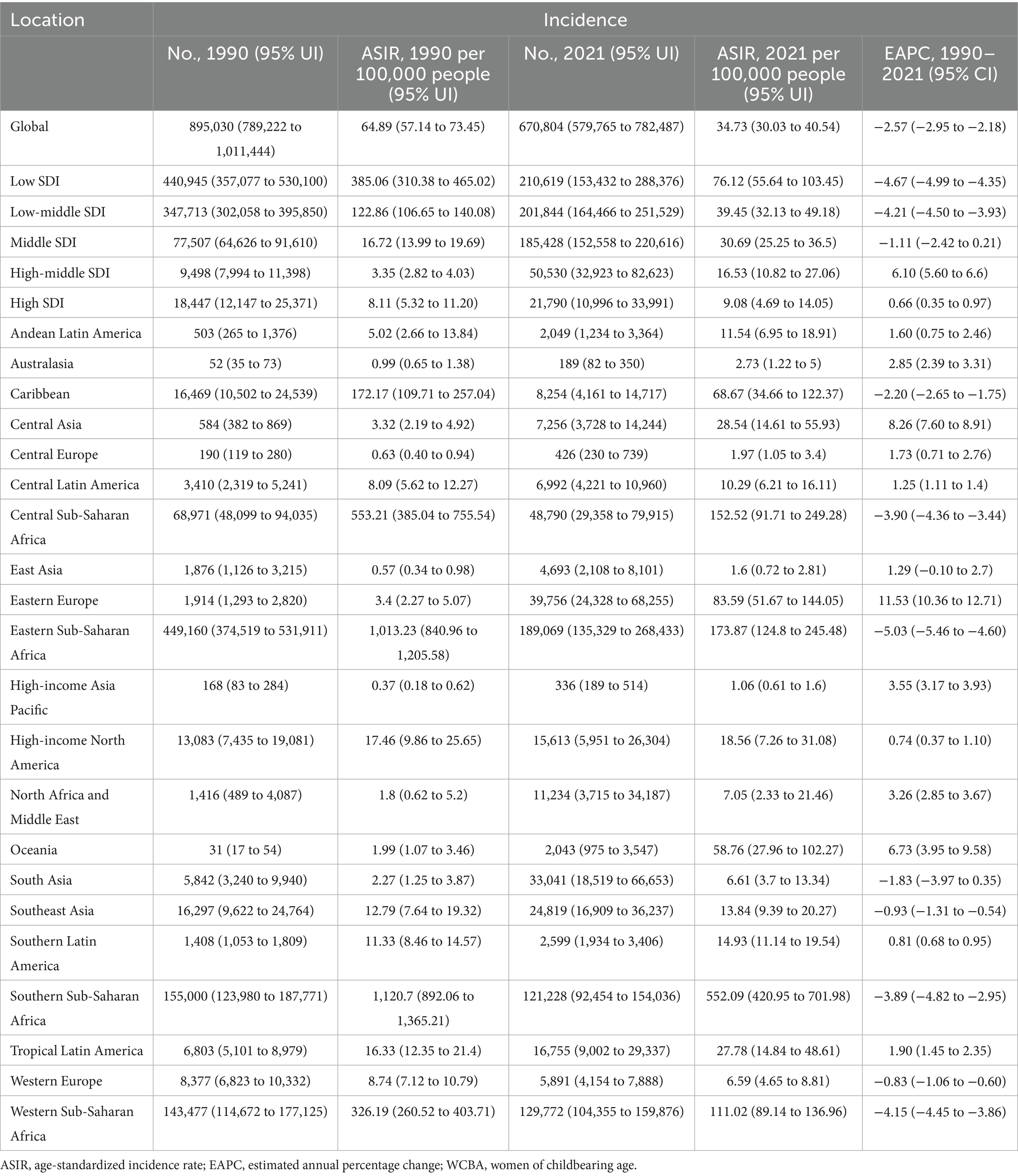
Table 1. The incidence of HIV/AIDS cases and rates among WCBA in 1990 and 2021, and the trends from 1990 to 2021.
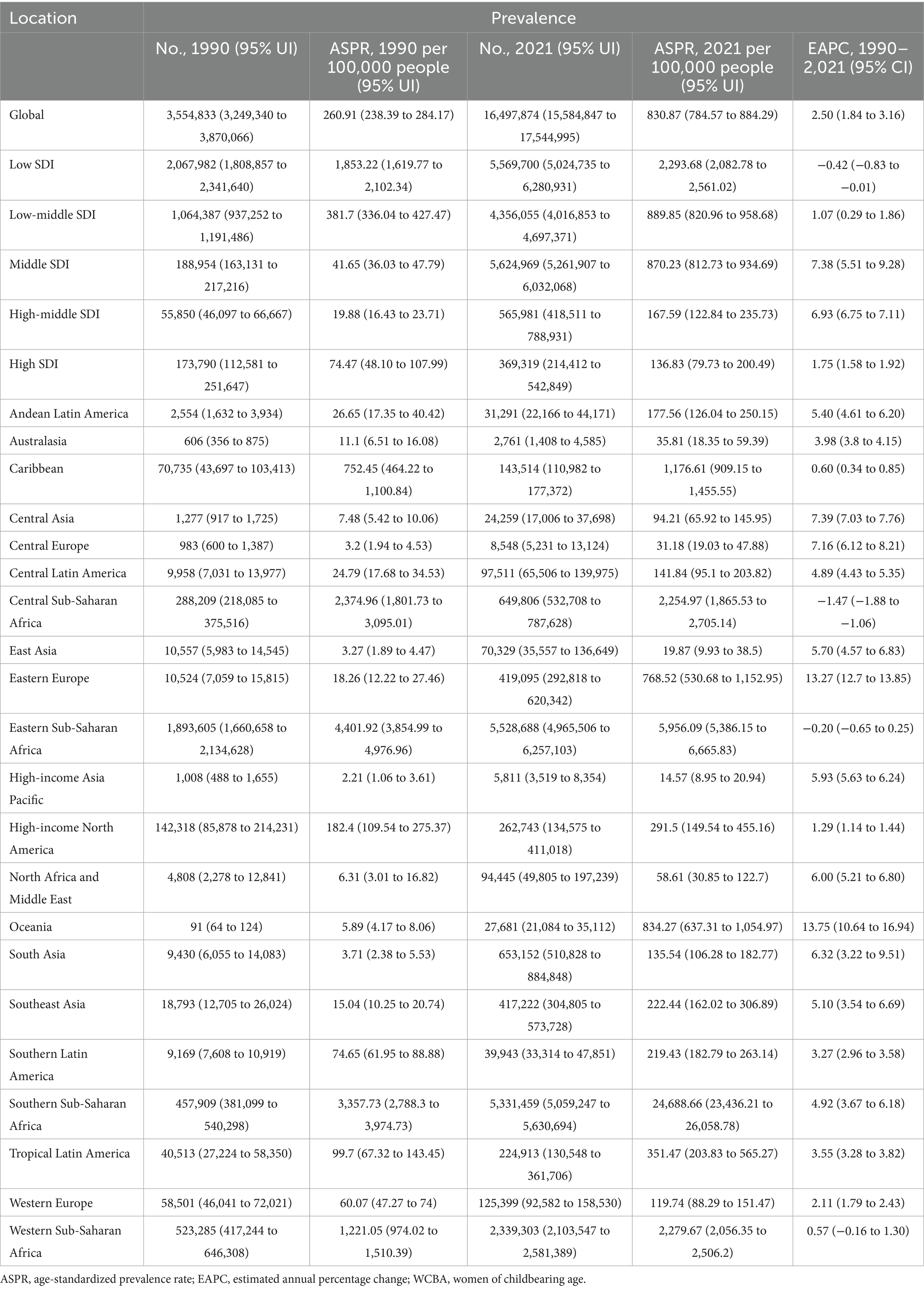
Table 2. The prevalence of HIV/AIDS cases and rates among WCBA in 1990 and 2021, and the trends from 1990 to 2021.
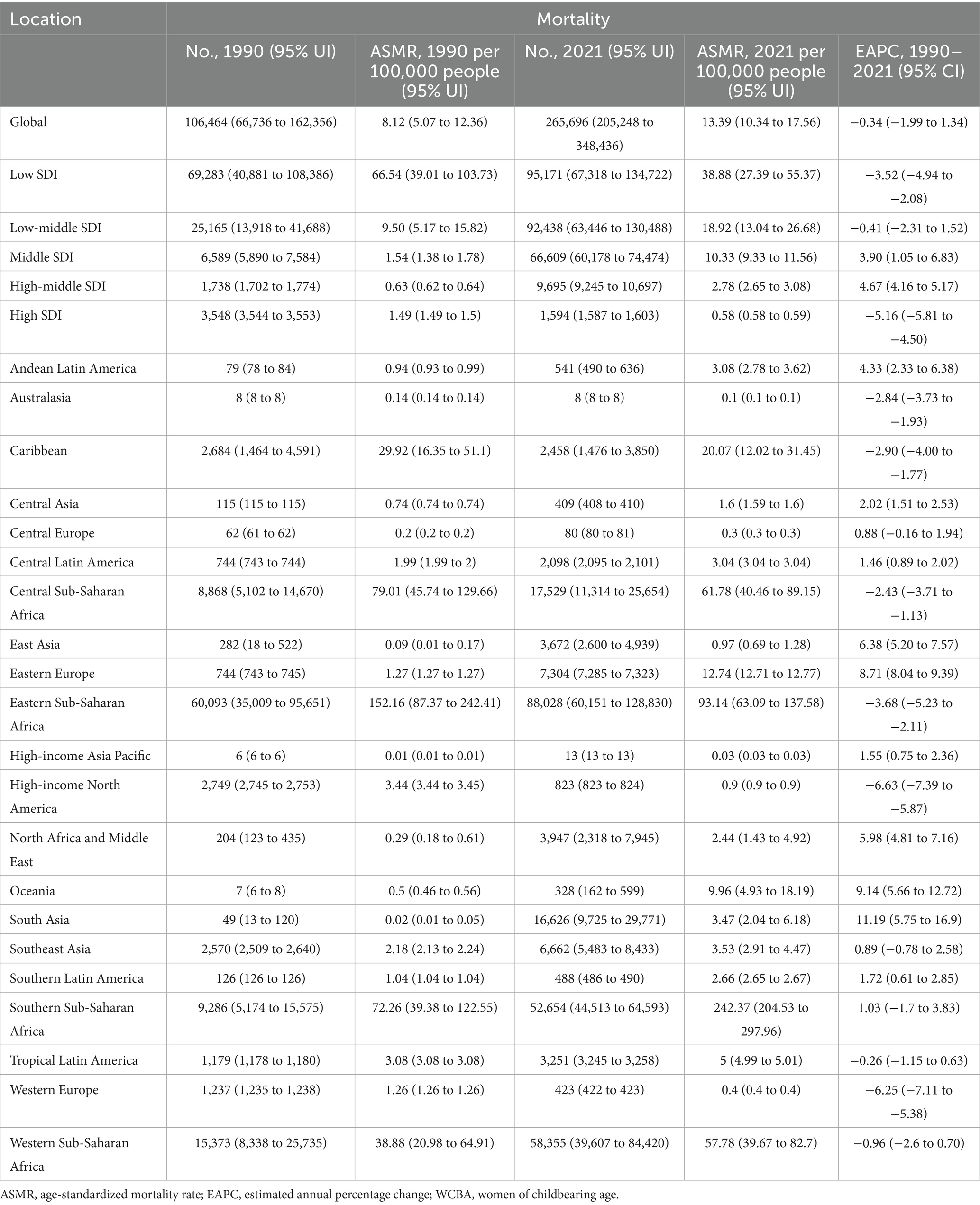
Table 3. The mortality of HIV/AIDS cases and rates among WCBA in 1990 and 2021, and the trends from 1990 to 2021.
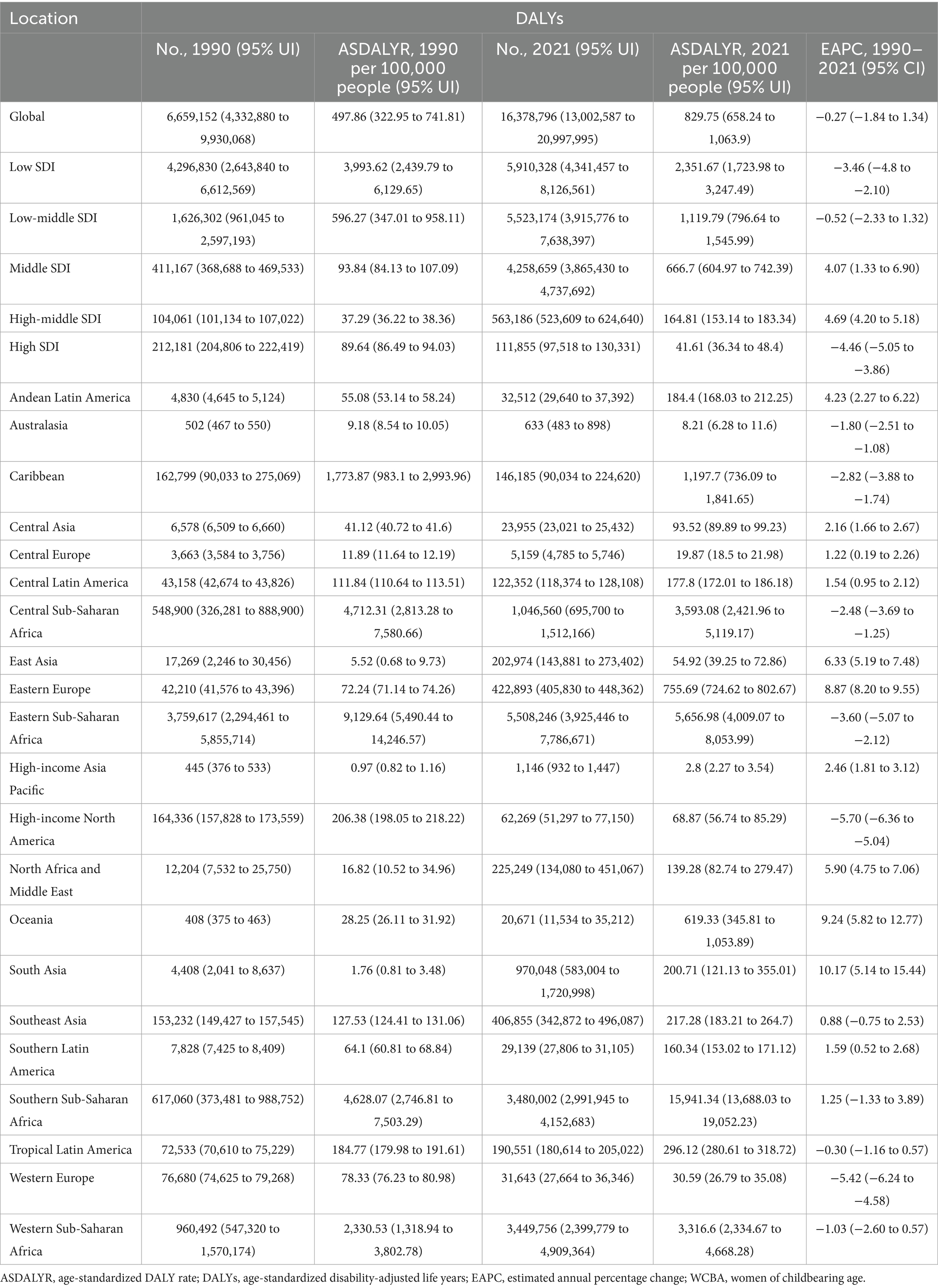
Table 4. The DALYs of HIV/AIDS cases and rates among WCBA in 1990 and 2021, and the trends from 1990 to 2021.
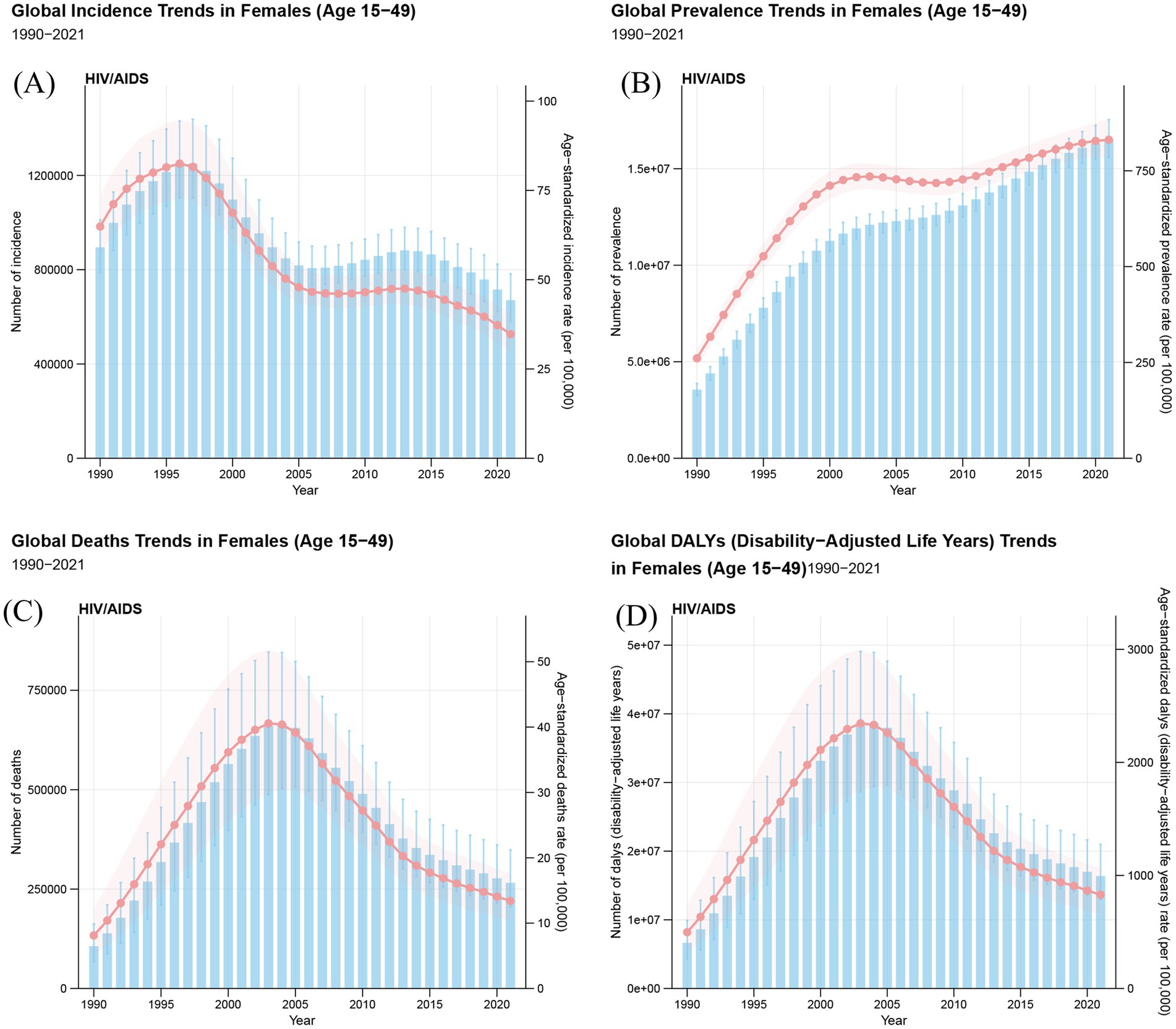
Figure 1. The trends in numbers and rates of incidence (A), prevalence (B), mortality (C), and DALYs (D) for HIV/AIDS among women of childbearing age in global from 1990 to 2021. DALYs, disability-adjusted life years.
3.2 SDI regional level
In 2021, the highest numbers of HIV/AIDS incidence, mortality and DALYs in WCBA globally were recorded in the low SDI region at 210,619 (95% UI: 153,432 to 288,376), 95,171 (95% UI: 67,318 to 134,722) and 5,910,328 (95% UI: 4,341,457 to 8,126,561), respectively. However, middle SDI region had the highest 2021 prevalence of all SDI regions at 5,624,969 (95% UI: 5,261,907 to 6,032,068). In 2021, low SDI region exhibited the highest ASIR, ASPR, ASMR, and ASDALYR at 76.12 (95% UI: 55.64 to 103.45), 2,293.68 (95% UI: 2,082.78 to 2,561.02), 38.88 (95% UI: 27.39 to 55.37), and 2,351.67 (95% UI: 1,723.98 to 3,247.49) per 100,000, respectively. From 1990 to 2021, incidence rates in high SDI and high-middle SDI regions demonstrated an upward trend, with the most significant increase occurring in high-middle SDI region, exhibiting an EAPC of 6.10 (95% CI: 5.60 to 6.60). Conversely, incidence rates in low-middle SDI and low SDI locations exhibited a downward trend, with the most pronounced decrease occurring in low SDI region, exhibiting an EAPC of −4.67 (95% CI: −4.99 to −4.35). The prevalence of most SDI regions exhibited an upward trend, with the exception of low SDI, which demonstrated a downward trend, exhibiting an EAPC of −0.42 (95% CI: −0.83 to −0.01). The data further revealed a downward trend in mortality and DALY rates for high SDI and low SDI regions from 1990 to 2021, while mortality and DALYs rates in high-middle and middle SDI areas showed an upward trend. Notably, high SDI region exhibited the most significant decline in mortality and DALY rates, with EAPCs of −5.16 (95% CI: −5.81 to −4.50) and −4.46 (95% CI: −5.05 to −3.86), respectively (Tables 1–4; Figure 2; Supplementary Figure S1).
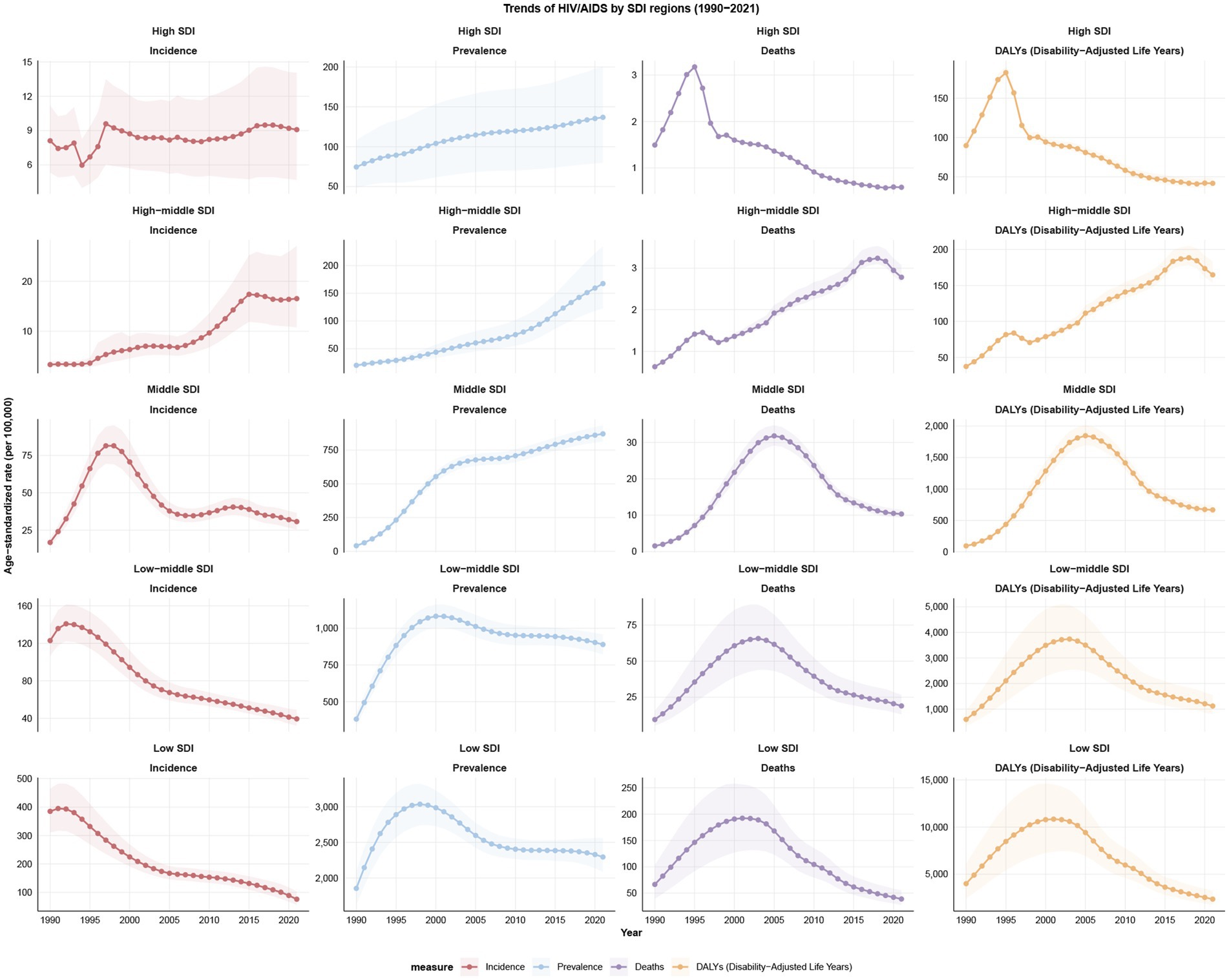
Figure 2. Trends of incidence, prevalence, mortality, and DALYs for HIV/AIDS among women of childbearing age by SDI regions from 1990 to 2021; DALYs, disability-adjusted life years; SDI, Socio-Demographic Index.
3.3 GBD regional level
In 2021, the top three regions in terms of incidence cases were Eastern Sub-Saharan Africa (189,069, 95% UI: 135,329 to 268,433), Western Sub-Saharan Africa (129,772, 95% UI: 104,355 to 159,876) and Southern Sub-Saharan Africa (121,228, 95% UI: 92,454 to 154,036). All three regions have reported more than 100,000 new cases. The highest prevalent cases of HIV/AIDS in 2021 had been recorded in Eastern Sub-Saharan Africa, with a total of 5,528,688 (95% UI: 4,965,506 to 6,257,103). The top three regions in terms of the number of deaths were Eastern Sub-Saharan Africa (88,028, 95% UI: 60,151 to 128,830), Western Sub-Saharan Africa (58,355, 95% UI: 39,607 to 84,420) and Southern Sub-Saharan Africa (52,654, 95% UI: 44,513 to 64,593) in 2021. The top three regions for DALYs were as follows: Eastern Sub-Saharan Africa (5,508,246, 95% UI: 3,925,446 to 7,786,671), Southern Sub-Saharan Africa (95% UI: 3,480,002, 2,991,945 to 4,152,683) and Western Sub-Saharan Africa (3,449,756, 95% UI: 2,399,779 to 4,909,364). In 2021, the top three regions in terms of ASIR were Southern Sub-Saharan Africa (552.09, 95% UI: 420.95 to 701.98), per 100,000, Eastern Sub-Saharan Africa (173.87, 95% UI: 124.8 to 245.48) per 100,000 and Central Sub-Saharan Africa (152.52, 95% UI: 91.71 to 249.28) per 100,000. Conversely, High-income Asia Pacific had the lowest ASIR at 1.06 (95% UI: 0.61 to 1.6) per 100,000. In 2021, Southern Sub-Saharan Africa had the highest ASPR of 24688.66 (95% UI: 23436.21 to 26058.78) per 100,000. However, high-income Asia Pacific has the lowest ASPR of 14.57 (95% UI: 8.95 to 20.94) per 100,000. By contrast, Southern Sub-Saharan Africa has the highest ASMR and ASDALYR of 242.37 (95% UI: 204.53 to 297.96) per 100,000 and 15941.34 (95% UI: 13688.03 to 19052.23) per 100,000, respectively in 2021 (Tables 1–4; Figure 3).
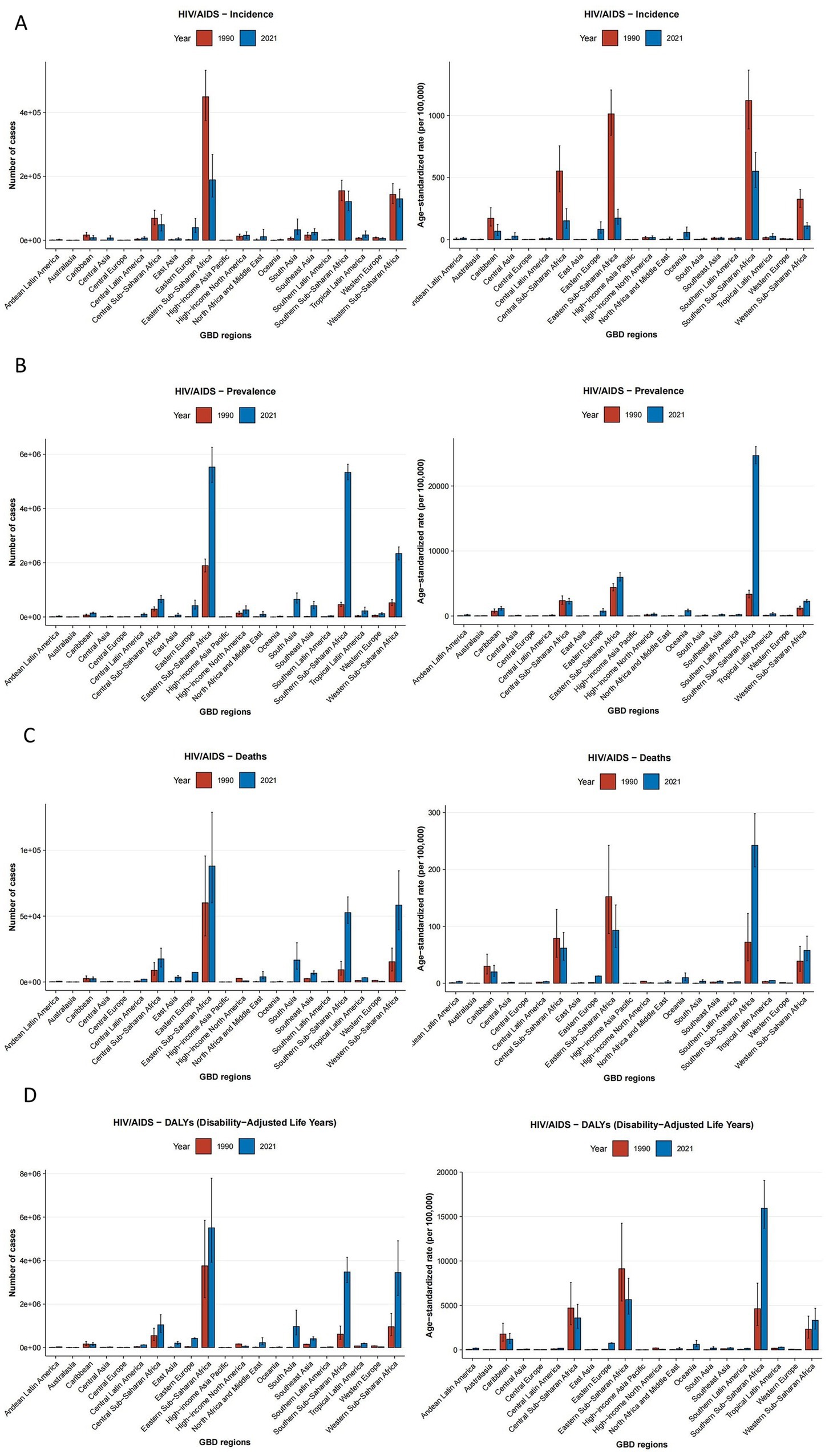
Figure 3. The numbers and rates of incidence (A), prevalence (B), mortality (C), and DALYs (D) for HIV/AIDS among women of childbearing age by 21 regions in 1990 and 2021. DALYs, disability-adjusted life years.
The region that has experienced the most significant increase in incidence over the past 32 years is Eastern Europe, with an EAPC of 11.53 (95% CI: 10.36 to 12.71). In contrast, Eastern Sub-Saharan Africa has demonstrated the largest decrease, exhibiting an EAPC of −5.03 (95% CI: −5.46 to −4.60). From 1990 to 2021, the majority of regions exhibited an upward trend in prevalence, with Oceania demonstrating the most significant increase, as indicated by an EAPC of 13.75 (95% CI: 10.64 to 16.94). Southern Sub-Saharan Africa demonstrated the largest increase in mortality and DALYs, with 11.19 (95% CI: 5.75 to 16.90) and 10.17 (95% CI: 5.14 to 15.44). This finding indicates a high burden of HIV/AIDS among WCBA in this region. High-income North America exhibited the most substantial declines in mortality and DALYs, with EAPCs of −6.63 (95% CI: −7.39 to −5.87) and −5.70 (95% CI: −6.36 to −5.04), respectively (Tables 1–4; Figure 3).
3.4 Countries level
In 204 countries and territories, the highest ASIR for HIV/AIDS among was observed in Equatorial Guinea (ASIR = 1217.3, 95% UI: 244.93 to 3255.72), Angola (ASIR = 431.35, 95% UI: 194.52 to 824.85) and Guinea-Bissau (ASIR = 406.88, 95% UI: 31.29 to 1149.83) per 100,000, respectively. The top three countries with the ASPR in 2021 were the Lesotho, Eswatini, and, South Africa, with rates of 34674.41 (95% UI: 29692.61 to 39180.09), 33810.75 (95% UI: 30340.38 to 37315.51), and 26684.61 (95% UI: 25064.63 to 28413.31) per 100,000, respectively. The top three with the ASMR in 2021 were the Lesotho, Eswatini, and Mozambique, with rates of 563.35 (95% UI: 299.99 to 936.66), 486.17 (95% UI: 213.16 to 947.87), and 322.18 (95% UI: 284.2 to 371.32) per 100,000, respectively. The top three countries in the 2021 ASDALYR ranking are consistent with ASMR (Figure 4; Supplementary Tables S1–S4).
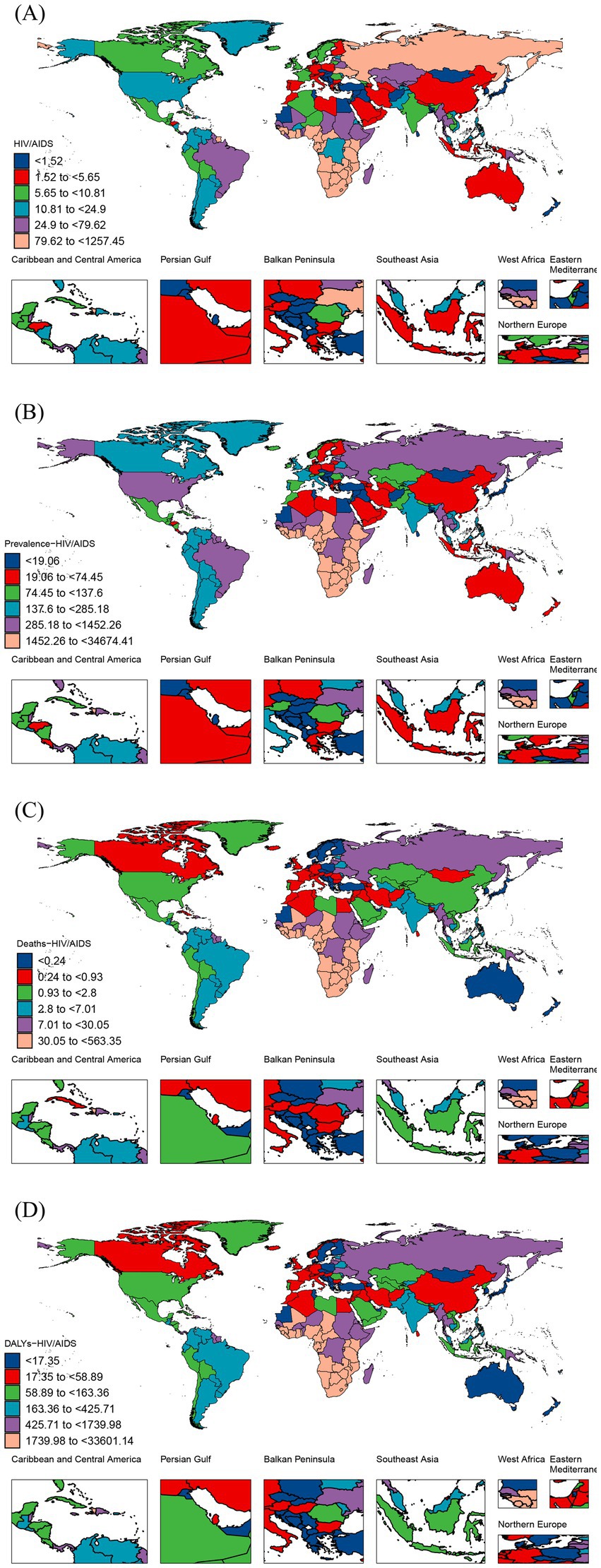
Figure 4. ASIR (A), ASPR (B), ASMR (C), and ASDALYR (D) for HIV/AIDS among women of childbearing age across 204 countries and territories in 2021. ASIR, age-standardized incidence rate; ASPR, age-standardized prevalence rate; ASMR, age-standardized mortality rate; ASDALYR, age-standardized disability-adjusted life years rate.
From 1990 to 2021, the incidence rates were on the rise in 54.4% of countries. The greatest increase in incidence of HIV/AIDS among WCBA were in Pakistan (EAPC = 32.38, 95% CI: 27.89 to 37.03). Conversely, the country with the most significant decreases in incidence was Burundi (EAPC = -13.82, 95% CI: −8.43 to −7.26). Between 1990 and 2021, the prevalence was increasing in 83.8% of countries. The greatest increase in incidence of HIV/AIDS among WCBA was Pakistan (EAPC = 35.52, 95% CI: 32.24 to 38.88). Conversely, the largest reduction in prevalence was in Burkina Faso, with EAPC of −5.94 (95% CI: −6.18 to −5.71). From 1990 to 2021, the mortality and DALYs showed a declining trend in approximately half of the countries. The largest decline was seen in Burkina Faso, with EAPCs of −9.59 (95% CI: −10.68 to −8.48), and −9.46 (95% CI: −10.48 to −8.43). Conversely, the country with the most significant increases was Pakistan, with EAPCs of 41.48 (95% CI: 38.43 to 44.61), and 40.56 (95% CI: 37.56 to 43.61) (Figure 4; Supplementary Tables S1–S4).
3.5 Age patterns
In 2021, the age group with the highest incident numbers of HIV/AIDS among WCBA in global was 25–29, the age group with the highest number of prevalent cases was 35–39, and the age group with the highest number of deaths and DALYs was 30–34. In 2021, the incidence, prevalence, mortality, and DALYs of HIV/AIDS among WCBA in global exhibited a first increasing and then decreasing trend with age. The incidence of the condition peaks in the 25–29 age group, the prevalence and mortality peak in the 40–44 age group, and the DALYs peak in the 30–34 age group (Figure 5; Supplementary Figure S2).
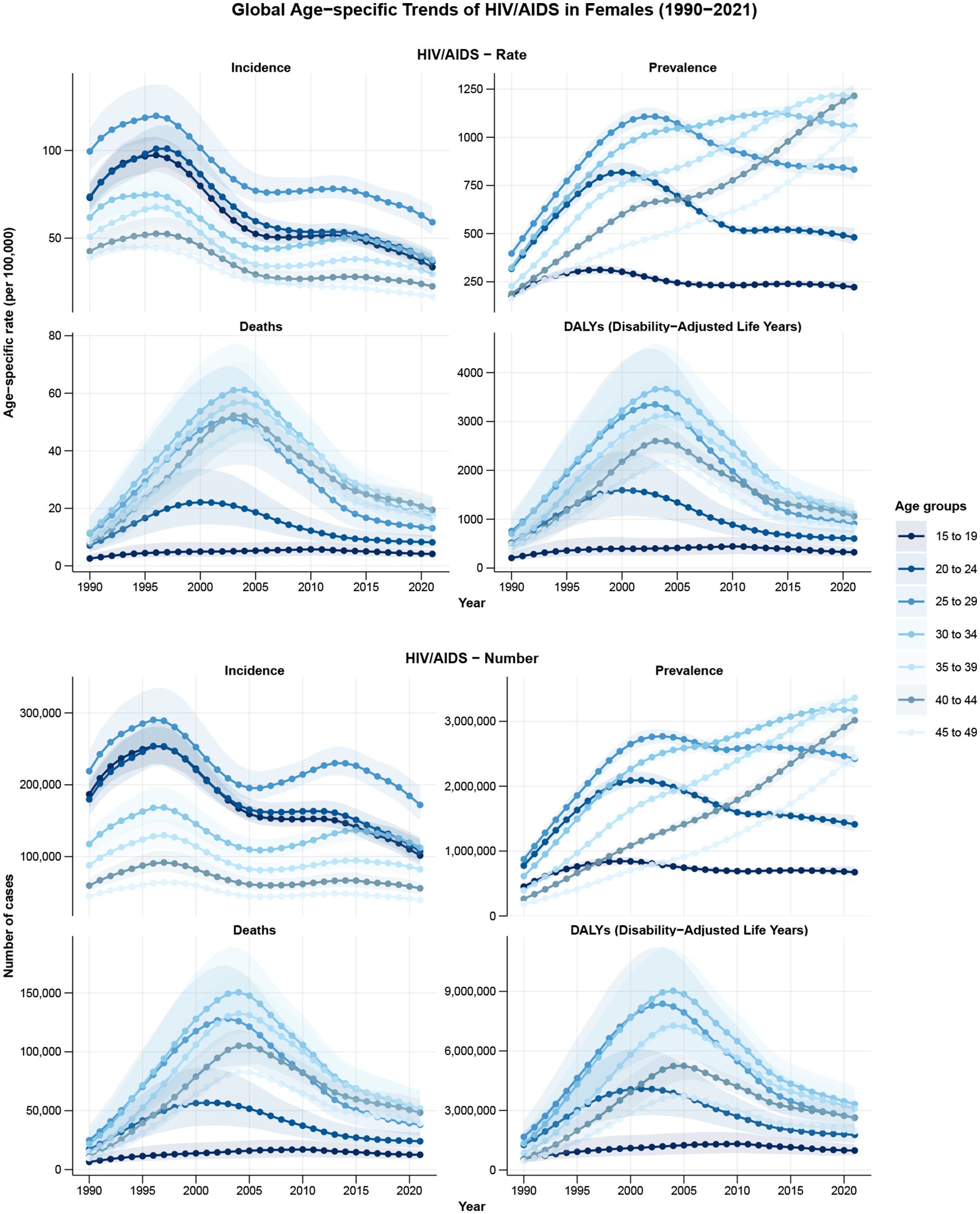
Figure 5. The trends of burden indicators for HIV/AIDS among women of childbearing age in different age-groups from 1990 to 2021.
3.6 The association between ASR and SDI
From 1990 to 2021, the relationship between SDI and ASIR, ASPR, ASMR, and ASDALYR exhibited significant variations, particularly evident in Southern Sub-Saharan Africa. As SDI increases, a decrease in ASIR and ASPR is evident in most regions. ASIR in Southern Sub-Saharan Africa peaks at SDI close to 0.6 and then declines rapidly. Concurrently, ASMR and ASDALYR demonstrate a downward trend in the majority of regions, with Eastern Sub-Saharan Africa, Central Sub-Saharan Africa, and Western Sub-Saharan Africa exhibiting an initial upward trend, followed by a subsequent decrease, at SDI values less than 0.4. ASMR and ASDALYR in Southern Sub-Saharan Africa peaked at SDI close to 0.6 and then declined rapidly, while the former three showed a more moderate downward trend (Figure 6).
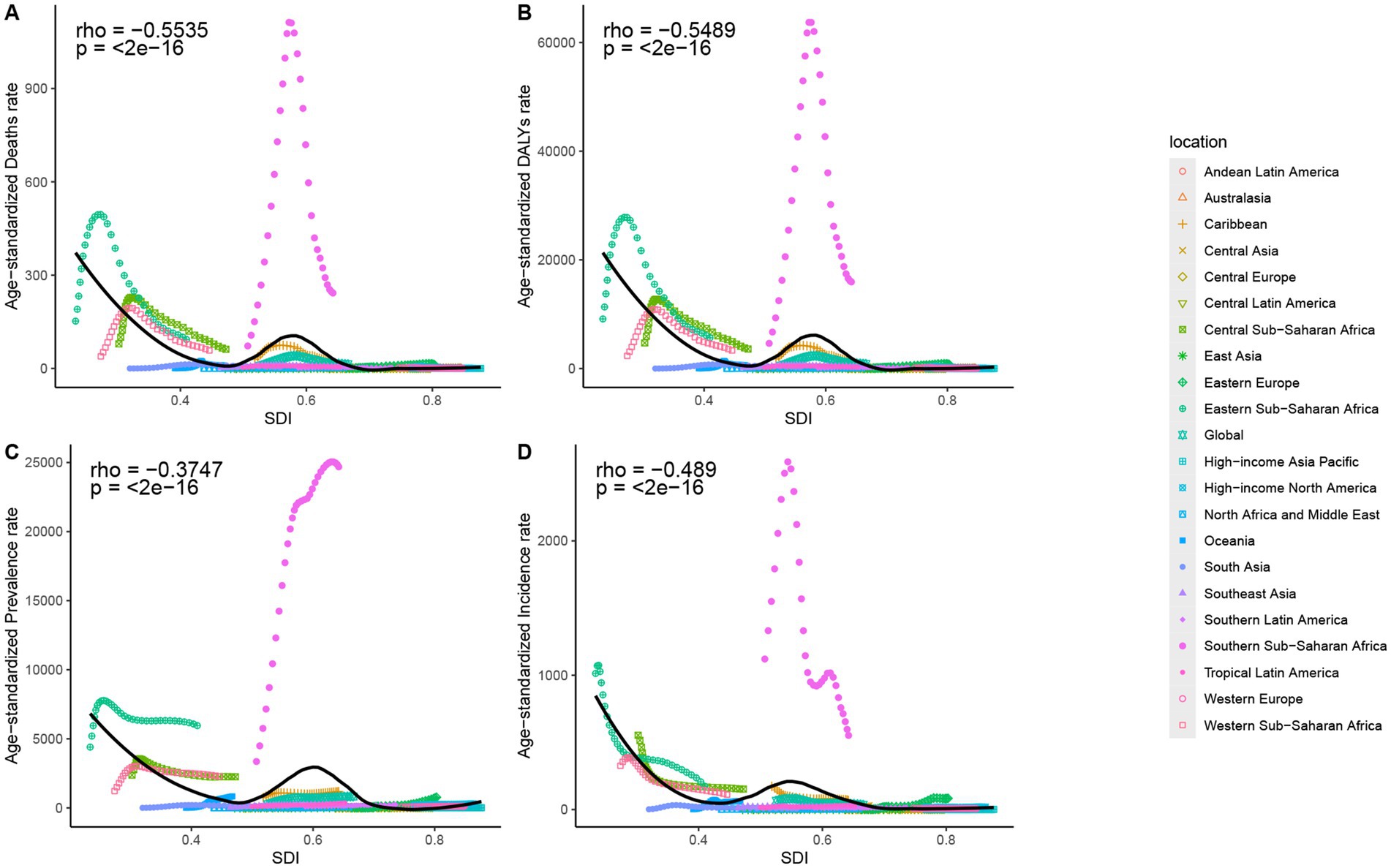
Figure 6. The associations between the SDI and ASMR (A), ASDALYR (B), ASPR (C), ASIR (D) for HIV/AIDS among women of childbearing age across 21 regions. ASIR, age-standardized incidence rate; ASPR, age-standardized prevalence rate; ASMR, age-standardized mortality rate; ASDALYR, age-standardized disability-adjusted life years rate; SDI, Socio-Demographic Index.
3.7 Decomposition analysis
From 1990 to 2021, the global incidence decreased significantly, with the greatest decrease occurring in low SDI region. The decline can be attributed to aging, population and epidemiological changes, which accounted for 14.6, −137.56 and 222.96% of the global decline in incidence, respectively. The impact of these various factors on the incidence of the disease varied according to geographical location. The population contribution was found to be most significant in the low SDI region, accounting for 265.46% of the total. Conversely, the Middle SDI region exhibited the most substantial increase in global prevalence. The impact of aging, demographic and epidemiological changes on the increase in global prevalence was 3.43, 25.79 and 70.78%, respectively. Globally, there was a significant increase in the number of deaths, with the largest increase recorded in the low-middle SDI region. The influence of aging, population and epidemiological changes accounted for 5.89, 41.06 and 53.05% of the global increase in deaths, respectively. A significant increase in DALYs was observed on a global scale, with the largest increase occurring in the low-middle SDI region. The same three factors accounted for 3.36, 41.75 and 54.89% of the increase in global DALYs, respectively. These findings indicate that expanding population sizes and epidemiological characteristics are significant contributors to the rising burden of disease in these regions (Supplementary Figure S3).
3.8 Joinpoint regression analysis
Joinpoint regression analyses demonstrated a general downward trend in ASIR (AAPC = −1.94; 95% CI: −2.05 to −1.82; p < 0.001) globally over the past 32 years. Conversely, the overall upward trend in ASPR (AAPC = 3.84; 95% CI: 3.79 to 3.91; p < 0.001) is significant. Of particular note is the downward trend in ASIR (APC = −7.09; 95% CI: −7.39 to −6.81; p < 0.001) from 1997 to 2005, and the subsequent downward trend in ASIR (APC = −4.52; 95% CI: −5.21 to −3.83; p < 0.001) from 2015 to 2021. Nevertheless, a rising trend was evident in all annual phases of ASPR, with inflection points occurring in 1992, 1995, 1998, 2001 and 2009. Global ASMR (AAPC = 1.58; 95% CI: 1.48 to 1.68; p < 0.001) and ASDALYR (AAPC = 1.61; 95% CI: 1.51 to 1.70; p < 0.001) demonstrated an overall upward trend, with the same inflection points (1994, 1999, 2003, 2006, 2015). ASMR exhibited a marked increase from 1990 to 1994 (APC = 24.14; 95% CI: 23.12 to 25.22; p < 0.001). However, from 2003 onwards, ASMR demonstrated a downward trend, with the most significant decline from 2006 to 2015 (APC = −8.15; 95% CI: −8.61 to −7.86; p < 0.001). The trend for ASDALYR was largely consistent with ASMR (Supplementary Figure S4).
3.9 Prediction analysis
Based on the Nordpred predictive analysis, it is projected that by 2046, the annual number of new cases will decrease to estimated 470,000 cases, while the annual number of prevalent cases will increase to estimated 18,000,000 cases. The annual number of deaths is also expected to rise, reaching estimated 210,000 cases by 2046. In 2046, the ASIR is anticipated to decline to 22.55, the ASPR to 818.46, and the ASMR to 9.77. Therefore, we observe that the burden of HIV/AIDS is gradually diminishing. However, the overall situation remains severe (Supplementary Figure S5).
4 Discussion
The 2021 United Nations General Assembly (UNGA) Political Declaration on HIV/AIDS (32), titled “Ending Inequalities and Getting on Track to End AIDS by 2030,” outlines ambitious targets, including reducing annual new HIV infections to <370,000 and AIDS-related deaths to <250,000 by 2025 (33). Central to this framework is addressing gender disparities, particularly reducing HIV incidence among women and ensuring 95% of women access sexual and reproductive health services by 2025 to mitigate the impact of gender-based violence on HIV transmission. However, limited studies have systematically quantified the global burden of HIV/AIDS among WCBA. This study, utilizing GBD 2021 data, provides the first comprehensive estimates of HIV/AIDS incidence, prevalence, mortality, and DALYs among WCBA over 32 years (1990–2021) and projects trends to 2046. Key findings include: first, the ASIR of HIV/AIDS among WCBA exhibited a declining trend globally, while the ASPR increased; Second, there are regional differences in the burden of HIV/AIDS among WCBA, with increasing trends in high and high-middle SDI regions and decreasing trends in middle, low-middle, and low SDI areas from 1990 to 2021. As SDI increases, ASIR and ASPR trend downward in most regions. The region with the largest increase in incidence was Eastern Europe, while the region with the largest decrease was Eastern Sub-Saharan Africa. Then, HIV/AIDS among WCBA had the highest incidence in the 25–29 year age group and the highest mortality and DALYs in the 30–34 year age group. Decomposition analyses revealed that expanding population base and epidemiological characteristics are determinants of the rising burden of HIV/AIDS. Projections show a declining trend in ASIR, ASPR and ASMR to 2046.
While a previous study (34) has examined global temporal trends in the incidence of mother-to-child transmission (MTCT) of infectious diseases among WCBA, critical gaps remain. Existing research lacks in-depth analyses of the underlying drivers of high HIV/AIDS prevalence in this population. To address these limitations, this study provides a comprehensive exploration through decomposition analysis, Joinpoint regression analysis and projections. While national data are indeed vital for informing local public health decisions, GBD-derived estimates offer a valuable complementary viewpoint. They can help fill in data gaps that may exist in certain regions or for specific sub-populations, and they also enable more straightforward comparisons across different countries and regions around the world. Furthermore, we propose evidence-based policy recommendations to guide governmental and public health agencies in designing targeted interventions. The underlying causes of the elevated prevalence of HIV/AIDS among WCBA are complex, encompassing a blend of biological, social, and economic factors. Research indicates that women have a significantly higher risk of HIV acquisition after a single exposure compared to men, due to the increased surface area of the cervicovaginal mucosa and heightened cellular immune activity in the vagina (35). Moreover, age has been recognized as a crucial determinant in the risk of HIV infection. Younger women demonstrate greater susceptibility to HIV than older women, a disparity potentially attributable to the larger expanse of vulnerable genital mucosa in the immature cervix and elevated inflammation levels in the reproductive tract among younger women, both of which are positively correlated with an increased risk of HIV infection (36, 37). In numerous areas with elevated HIV prevalence, gender inequality is widespread, and women frequently encounter obstacles in sexual relationships and struggle to reject unsafe sexual practices (38). Early marriage, multiple sexual partners, and sexual violence are widespread, significantly increasing the risk of infection (6). A study indicated that women with a history of multiple sexual partners possess an approximately 1.3-fold increased likelihood of HIV infection relative to their counterparts (6, 39). The economic difficulties faced by numerous women result in the exploitation of sexual services for essential survival resources, and the prevalence of multiple concurrent sexual partners markedly heightens the risk of exposure. The estimated prevalence of HIV among women in slum areas is 13 percent (40). Furthermore, the restricted educational achievements of WCBA directly lead to inadequate health literacy and a failure to access or understand preventive information. A study in Malawi indicated that merely 12.5 percent of women were cognizant of HIV pre-exposure prophylaxis (PrEP), with awareness significantly lower among those lacking secondary education, and substantially below that of men (41).
In 2021, the incidence, prevalence, mortality, and DALY rates were highest in low SDI region. This discovery indicates an increased prevalence of HIV/AIDS in areas marked by low SDI levels. This phenomenon is chiefly ascribed to the restricted availability of medical resources and the inadequate healthcare capacity in these areas (6). This study has identified a significant upward trend in the incidence of HIV/AIDS among WCBA, with the most pronounced increases observed in high-middle SDI region. The most credible hypothesis is that high-middle SDI districts are predominantly experiencing rapid economic development, characterized by urbanization resulting in significant population migration (e.g., rural–urban mobility). These populations frequently face a deficiency in social security, a rise in transient sexual relationships, and insufficient access to sexual health services. The influence of economic growth and social development on mitigating the disease burden is obstructed by entrenched cultural contexts and the stigma linked to HIV/AIDS among WCBA (3). From 1990 to 2021, Eastern Europe experienced the most significant rise in HIV/AIDS incidence among WCBA. The principal transmission risk has transitioned from unsafe injection practices to heterosexual contact, yet access to opioid agonist therapy and needle-syringe programs remains constrained (42). Moreover, the Russo-Ukrainian war in recent years has obstructed efforts to test and treat individuals, and the ensuing economic difficulties have forced some women to participate in high-risk sex work, which is a significant concern (43). The war in Ukraine conflict has exacerbated gaps in HIV services. As a result, projections may underestimate the burden in crisis-affected areas, reinforcing the need for adaptive health systems. However, implementing these policy recommendations in real-world settings presents significant challenges, particularly in fragile or conflict-affected regions. For example, in Ukraine and Yemen, ongoing conflicts have severely disrupted healthcare infrastructure (44–46). Such disruption makes the delivery of PrEP or ART services to those in need extremely difficult. In these settings, expanding PrEP coverage or ART access requires more than just medical supplies. It also involves rebuilding healthcare facilities, training local healthcare workers, and ensuring the safe transportation of medications. Furthermore, flexible approaches such as mobile clinics and community-based distribution systems are essential for expanding PrEP coverage in these dynamic environments. Additionally, resource allocation represents a persistent challenge. While international guidelines may recommend certain high-impact interventions, local governments often lack the financial resources to implement them. This situation necessitates innovative financing mechanisms and partnerships to mobilize the required resources (3). Between 1990 and 2021, Eastern Sub-Saharan Africa experienced the most substantial reduction in incidence. This decline signifies that the notable successes of this region in decreasing HIV/AIDS incidence stem from sustained advancement. This discovery aligns with the substantial advancements achieved in the accessibility of ART, PrEP, and voluntary medical male circumcision (47–49). Nevertheless, the region remains beset by discriminatory conditions and domestic laws that not only sustain the epidemic but also exacerbate its persistence, leading to elevated prevalence rates.
Among the 204 countries or territories, Pakistan has experienced the most significant rise in HIV/AIDS incidence. The literacy rate in Pakistan is notably low, particularly among females, resulting in inadequate awareness and understanding of HIV/AIDS and its prevention (50). In WCBA, the likelihood of HIV transmission is markedly heightened by practices such as extramarital sexual relations, unsafe blood transfusions, and the utilization of contaminated syringes. Furthermore, the widespread discrimination and stigma faced by individuals with HIV/AIDS in Pakistani society has resulted in a considerable number of infected individuals choosing to hide their status (51). This has impeded efforts for early detection and treatment and may also heighten the transmission risk within the community. The government of Pakistan must implement measures to address these issues, including the provision of sex education for WCBA and the empowerment of women, to mitigate the burden of HIV/AIDS among WCBA (52). Regarding age-specific patterns, our analysis revealed that women aged 35–39 years bore the highest prevalence of HIV/AIDS, while those aged 30–34 years experienced the peak mortality and DALY burden. The natural history of HIV involves a prolonged clinical latency period. Women infected at younger ages typically progress to advanced stages after 5–10 years (53), leading to concentrated diagnosis and documented morbidity in the 35–39 age group. Furthermore, cumulative exposure risk escalates with age. Women over 30 face amplified infection risks due to extended periods of sexual activity, partner turnover, and vertical transmission exposure during pregnancy (54, 55). Critically, the peak in mortality and DALYs at 30 to 34 years is indicative of significant structural barriers in high-burden settings. Younger women often experience delayed diagnosis due to the stigma associated with HIV and the fragmentation of health services. Even after diagnosis, timely access to ART is frequently impeded by financial limitations, medication shortages, and concerns regarding side effects (3, 5). As a result, untreated infections tend to progress to severe and often fatal complications by their early thirties. We have emphasized the importance of public health interventions, such as improving the accessibility of HIV testing services, reducing the stigma associated with HIV infection, and enhancing the affordability of ART, to reduce the disease burden of HIV/AIDS among WCBA.
Joinpoint regression analysis indicated a significant decline in incidence from 1997 to 2005, coinciding with the introduction of ART in 1996 (56). A subsequent decrease in incidence was noted from 2015 to 2021. The decrease can be ascribed to the implementation of the UNAIDS fast-track strategy in 2016, which set mid-term 90–90-90 testing and treatment objectives for 2020 (33). These objectives are crucial for accomplishing the global aim of eradicating AIDS by 2030 (32). Decomposition analyses reveal that population and epidemiological changes significantly impact the burden of DALYs related to HIV/AIDS among WCBA, both globally and across SDI regions. This indicates that global population growth is directly contributing to the rise in the number of WCBA living with HIV/AIDS. The analysis indicates that epidemiological shifts, especially changes in HIV/AIDS transmission dynamics and population susceptibility, significantly contribute to the increase of DALYs. This highlights the necessity of ongoing monitoring and the modification of prevention and control strategies to tackle the global issue of HIV/AIDS. Predictive analyses indicate a slight decrease in ASPR, alongside more significant reductions in ASIR and ASMR. The significant reductions in ASIR and ASMR reflect considerable global progress in the prevention, management, and treatment of HIV/AIDS. The slight decrease in ASPR indicates the difficulties related to long-term disease management. This highlights the necessity of ongoing monitoring, enhancing prevention and control measures, and fortifying international collaboration.
In the last 30 years, the advancement of ART has significantly influenced the natural progression of HIV infection. The emergence of early diagnosis and the standardization of combination antiretroviral therapy (cART) have initiated a fundamental change in the management of HIV infection. During the 1980s, HIV infection was marked by a significant mortality rate, with an average life expectancy of merely 1–2 years post-diagnosis. The introduction of cART has converted HIV infection into a manageable chronic condition. Clinical studies indicate that 20-year-old female patients commencing ART can anticipate an increase in life expectancy of approximately 9 years (57). The global HIV epidemic persists as a serious concern, with the 2023 UNAIDS report revealing around 1.3 million new infections in 2022, and young women in Sub-Saharan Africa aged 15–24 being infected at three times the rate of their male counterparts in the same age group. This concerning epidemiological profile highlights the urgent necessity for the execution of effective preventive measures for at-risk populations, especially WCBA (4).
In the domain of HIV prevention strategies, HIV testing has become a significant secondary prevention measure, enhancing traditional behavioral interventions and condom use. The prompt diagnosis and treatment of bacterial sexually transmitted infections (STIs) have proven to significantly aid in the prevention of HIV (58). Over the past 15 years, there has been considerable advancement in biomedical prevention strategies, including the creation of PrEP and post-exposure prophylaxis (PEP) (59, 60). The utilization of PrEP has been evidenced to diminish the likelihood of HIV infection by as much as 92 percent, and long-acting injectable PrEP (e.g., cabotegravir), upon its approval in the United States in 2021, has exhibited superior results compared to oral PrEP (61). African nations have made substantial advancements in combating AIDS, evidenced by a 56 percent reduction in infections in Sub-Saharan Africa since 2010, according to the latest UNAIDS 2023 report (4). A study reveals that Sub-Saharan Africa is adopting universal testing and treatment (UTT) to diminish HIV transmission, aspiring to achieve the 90–90-90 targets set by UNAIDS (62, 63). Due to the considerable regional variability in HIV epidemiological profiles, there is an urgent necessity to enact differentiated policy reforms. HIV prevention and control strategies for WCBA should encompass multifaceted interventions, including the optimization of policy frameworks, enhancement of socio-economic empowerment, promotion of participatory community governance, and expansion of community-based rapid testing networks (64).
The global HIV prevention and control framework presently utilizes a multifaceted array of strategies, encompassing MTCT, voluntary male circumcision (VMMC), barrier methods, varied PrEP options (including oral and long-acting injectable forms), and behavioral intervention programs (65–67). The expansion and enhancement of these interventions for the key population of WCBA is a primary emphasis of national AIDS programs. The continuous enhancement of prevention and control strategies necessitates augmented financial investment and a methodical implementation approach that targets constraints such as socio-cultural factors, cognitive barriers, stigma and discrimination, and inequitable access to services. It is essential to guarantee that all individuals can accurately evaluate their infection risk and have access to testing services, both institutional and self-administered, that are devoid of financial burdens and social bias. The current treatment and prevention framework comprises three pillars (treatment, prevention, and diagnosis), yet progress toward the global objective of eradicating the AIDS epidemic can be expedited through the tailored enhancement of service models, precision, and scalability.
Nonetheless, it is crucial to acknowledge that the study possesses certain limitations. First, our analysis relied on model-derived estimates obtained from the GBD 2021 dataset rather than actual surveillance data, and there may be inherent bias between them that could affect the accuracy of the results. Secondly, as an ecological analysis, our study identifies population-level trends but cannot elucidate individual risk factors including sexual behaviors, stigma-related care barriers, and socioeconomic status. Future research linking macro-level burden with micro-level survey data is critical to inform targeted interventions. Thirdly, the lack of data from certain low- and middle-income countries may undermine the accuracy of the estimates. In low- and middle-income countries, the limited accessibility to healthcare services can hinder the ability to conduct comprehensive HIV screening and diagnosis, leading to incomplete case reporting, particularly among economically and socially disadvantaged groups. This situation may have been exacerbated by the COVID-19 pandemic (68), as health systems in these areas often have limited adaptive capacity to handle additional stress. Fourthly, the actual definition of WCBA (15–49 years) is globally inconsistent, potentially underestimating the disease burden in this group. Additionally, the utilization of static SDI categories also undermines the ability of countries to grasp how their socioeconomic evolves over time. Finally, wide UIs in settings like Equatorial Guinea reflect both data scarcity and epidemiological volatility. This suggests that we should interpret rankings from such countries with caution, given the limited surveillance infrastructure and data volatility.
5 Conclusion
HIV/AIDS among WCBA constitutes a substantial global health burden. Low SDI region, particularly in Sub-Saharan Africa, account for a disproportionate share of the global HIV/AIDS burden in WCBA, despite recent declines in incidence rates. Conversely, Eastern Europe has experienced a marked upward trend in incidence. Furthermore, the disease burden exhibits different distribution across age groups. Governments urgently need to implement context-specific interventions to address these disparities and further reduce the global burden of HIV/AIDS among WCBA across all regions.
Data availability statement
Publicly available datasets were analyzed in this study. This data can be found at: the data is sourced from a public database, accessible via the following link: https://vizhub.healthdata.org/gbd-results/.
Author contributions
MT: Writing – original draft, Writing – review & editing. JS: Writing – original draft, Writing – review & editing. YJ: Writing – original draft, Writing – review & editing. YL: Writing – original draft, Writing – review & editing. SL: Writing – original draft, Writing – review & editing. YS: Writing – original draft, Writing – review & editing. WW: Writing – original draft, Writing – review & editing. JT: Writing – original draft, Writing – review & editing. ZC: Writing – original draft, Writing – review & editing.
Funding
The author(s) declare that no financial support was received for the research and/or publication of this article.
Acknowledgments
We extend our appreciation to the Institute for Health Metrics and Evaluation for granting access to the essential GBD data.
Conflict of interest
The authors declare that the research was conducted in the absence of any commercial or financial relationships that could be construed as a potential conflict of interest.
Generative AI statement
The authors declare that no Gen AI was used in the creation of this manuscript.
Publisher’s note
All claims expressed in this article are solely those of the authors and do not necessarily represent those of their affiliated organizations, or those of the publisher, the editors and the reviewers. Any product that may be evaluated in this article, or claim that may be made by its manufacturer, is not guaranteed or endorsed by the publisher.
Supplementary material
The Supplementary material for this article can be found online at: https://www.frontiersin.org/articles/10.3389/fmed.2025.1605092/full#supplementary-material
Footnotes
References
1. Ghosn, J, Taiwo, B, Seedat, S, Autran, B, and Katlama, C. HIV. Lancet. (2018) 392:685–97. doi: 10.1016/s0140-6736(18)31311-4
2. Simon, V, Ho, DD, and Abdool Karim, Q. HIV/AIDS epidemiology, pathogenesis, prevention, and treatment. Lancet. (2006) 368:489–504. doi: 10.1016/s0140-6736(06)69157-5
3. GBD 2021 HIV Collaborators. Global, regional, and national burden of HIV/AIDS, 1990-2021, and forecasts to 2050, for 204 countries and territories: the global burden of disease study 2021. Lancet HIV. (2024) 11:e807–22. doi: 10.1016/s2352-3018(24)00212-1
5. GBD 2019 HIV Collaborators. Global, regional, and national sex-specific burden and control of the HIV epidemic, 1990-2019, for 204 countries and territories: the global burden of diseases study 2019. Lancet HIV. (2021) 8:e633–51. doi: 10.1016/s2352-3018(21)00152-1
6. Gedefie, A, Muche, A, Mohammed, A, Ayres, A, Melak, D, Abeje, ET, et al. Prevalence and determinants of HIV among reproductive-age women (15-49 years) in Africa from 2010 to 2019: a multilevel analysis of demographic and health survey data. Front Public Health. (2024) 12:1376235. doi: 10.3389/fpubh.2024.1376235
7. Koay, WLA, Zhang, J, Manepalli, KV, Griffith, CJ, Castel, AD, Scott, RK, et al. Prevention of perinatal HIV transmission in an area of high HIV prevalence in the United States. J Pediatr. (2021) 228:101–9. doi: 10.1016/j.jpeds.2020.09.041
8. Atkinson, A, Tulloch, K, Boucoiran, I, and Money, D. Guideline no. 450: care of pregnant women living with HIV and interventions to reduce perinatal transmission. J Obstet Gynaecol Can. (2024) 46:102551. doi: 10.1016/j.jogc.2024.102551
9. Gourlay, A, Walker, D, Singh, S, Mata, M, and Birdthistle, I. Gender-transformative HIV and SRHR programme approaches for adolescents and young people: a realist review to inform policy and programmes. BMJ Glob Health. (2024) 9:363. doi: 10.1136/bmjgh-2023-014363
10. Carvalho, S, Lee, T, Tulloch, KJ, Sauve, LJ, Samson, L, Brophy, JC, et al. Prescribing patterns of antiretroviral treatments during pregnancy for women living with HIV in Canada 2004-2020: A surveillance study. HIV Med. (2023) 24:130–8. doi: 10.1111/hiv.13346
11. Gopalakrishnan, L, Mulauzi, N, Mkandawire, J, Ssewamala, FM, Tebbetts, S, Neilands, TB, et al. Effects of economic empowerment and relationship strengthening intervention on financial behaviors among couples living with HIV: the Mlambe pilot trial in Malawi. SSM Popul Health. (2025) 29:101768. doi: 10.1016/j.ssmph.2025.101768
12. Teshale, AB, and Tesema, GA. Socioeconomic inequality in knowledge about HIV and its contributing factors among women of reproductive age in sub-Saharan Africa: A multicountry and decomposition analysis. HIV AIDS. (2023) 15:53–62. doi: 10.2147/hiv.S392548
13. Sardashti, S, Samaei, M, Firouzeh, MM, Mirshahvalad, SA, Pahlaviani, FG, and SeyedAlinaghi, S. Early initiation of antiretroviral treatment: challenges in the Middle East and North Africa. World J Virol. (2015) 4:134–41. doi: 10.5501/wjv.v4.i2.134
14. Chevalier, JM, Hansen, MA, Coskun, E, Sy, KTL, Drakes, J, Dowling, S, et al. Cost-effectiveness of intervention combinations towards the elimination of vertical transmission of HIV in limited-resource settings: a mathematical modelling study. Lancet Glob Health. (2024) 12:e457–66. doi: 10.1016/s2214-109x(23)00588-0
15. Hessamfar-Bonarek, M, Morlat, P, Salmon, D, Cacoub, P, May, T, Bonnet, F, et al. Causes of death in HIV-infected women: persistent role of AIDS. The 'Mortalité 2000 & 2005' surveys (ANRS EN19). Int J Epidemiol. (2010) 39:135–46. doi: 10.1093/ije/dyp300
16. Dinçer, M, Köse, N, and Ünal, E. The role of socioeconomic and behavioral factors in HIV-related deaths. Humanit Soc Sci Commun. (2024) 11:1588. doi: 10.1057/s41599-024-04121-y
17. GBD 2021 Diseases and Injuries Collaborators. Global incidence, prevalence, years lived with disability (YLDs), disability-adjusted life-years (DALYs), and healthy life expectancy (HALE) for 371 diseases and injuries in 204 countries and territories and 811 subnational locations, 1990-2021: a systematic analysis for the global burden of disease study 2021. Lancet. (2024) 403:2133–61. doi: 10.1016/s0140-6736(24)00757-8
18. GBD 2021 Causes of Death Collaborators. Global burden of 288 causes of death and life expectancy decomposition in 204 countries and territories and 811 subnational locations, 1990-2021: a systematic analysis for the global burden of disease study 2021. Lancet. (2024) 403:2100–32. doi: 10.1016/s0140-6736(24)00367-2
19. Yan, W, Liu, M, Jing, W, Kang, L, Zhang, N, Sun, H, et al. Disparities in the incidence, mortality and disability-adjusted life years of 33 early-onset cancer groups globally, 2012-2021: a systematic analysis. Exp Hematol Oncol. (2025) 14:38. doi: 10.1186/s40164-025-00634-7
20. Jin, W, Huang, K, Ding, Z, Zhang, M, Li, C, Yuan, Z, et al. Global, regional, and national burden of esophageal cancer: a systematic analysis of the global burden of disease study 2021. Biomark Res. (2025) 13:3. doi: 10.1186/s40364-024-00718-2
21. Sun, P, Yu, C, Yin, L, Chen, Y, Sun, Z, Zhang, T, et al. Global, regional, and national burden of female cancers in women of child-bearing age, 1990-2021: analysis of data from the global burden of disease study 2021. EClinicalMedicine. (2024) 74:102713. doi: 10.1016/j.eclinm.2024.102713
22. He, H, Ou, Z, Yu, D, Li, Y, Liang, Y, He, W, et al. Spatial and temporal trends in HIV/AIDS burden among worldwide regions from 1990 to 2019: A secondary analysis of the global burden of disease study 2019. Front Med. (2022) 9:808318. doi: 10.3389/fmed.2022.808318
23. Haagsma, JA, James, SL, Castle, CD, Dingels, ZV, Fox, JT, Hamilton, EB, et al. Burden of injury along the development spectrum: associations between the socio-demographic index and disability-adjusted life year estimates from the global burden of disease study 2017. Inj Prev. (2020) 26:i12–26. doi: 10.1136/injuryprev-2019-043296
24. Zhao, M, Zhai, H, Li, H, Wei, F, Ma, H, Liu, Y, et al. Age-standardized incidence, prevalence, and mortality rates of autoimmune diseases in adolescents and young adults (15-39 years): an analysis based on the global burden of disease study 2021. BMC Public Health. (2024) 24:1800. doi: 10.1186/s12889-024-19290-3
25. Yang, X, Zhang, T, Zhang, X, Chu, C, and Sang, S. Global burden of lung cancer attributable to ambient fine particulate matter pollution in 204 countries and territories, 1990-2019. Environ Res. (2022) 204:112023. doi: 10.1016/j.envres.2021.112023
26. Yang, X, Chen, H, Zhang, T, Yin, X, Man, J, He, Q, et al. Global, regional, and national burden of blindness and vision loss due to common eye diseases along with its attributable risk factors from 1990 to 2019: a systematic analysis from the global burden of disease study 2019. Aging. (2021) 13:19614–42. doi: 10.18632/aging.203374
27. Kim, HJ, Fay, MP, Feuer, EJ, and Midthune, DN. Permutation tests for joinpoint regression with applications to cancer rates. Stat Med. (2000) 19:335–51. doi: 10.1002/(sici)1097-0258(20000215)19:3<335::aid-sim336>3.0.co;2-z
28. Qiu, H, Cao, S, and Xu, R. Cancer incidence, mortality, and burden in China: a time-trend analysis and comparison with the United States and United Kingdom based on the global epidemiological data released in 2020. Cancer Commun. (2021) 41:1037–48. doi: 10.1002/cac2.12197
29. Das, GP. Standardization and decomposition of rates from cross-classified data. Genus. (1994) 50:171–96.
30. Huang, G, Wang, Y, Qin, B, Zeng, J, Tan, H, Zhang, D, et al. Global, regional and national burdens of nasopharynx cancer in the adolescents and young adults from 1990 to 2019 and its predictions. BMC Cancer. (2024) 24:720. doi: 10.1186/s12885-024-12480-7
31. Xu, Z, and Hertzberg, VS. Bayesian area-age-period-cohort model with carcinogenesis age effects in estimating cancer mortality. Cancer Epidemiol. (2013) 37:593–600. doi: 10.1016/j.canep.2013.07.002
32. UNAIDS Political declaration on HIV and AIDS: ending inequalities and getting on track to end AIDS by 2030 (2021)
34. Jin, Q, Zhou, M, Sun, M, Ning, B, Liu, M, Zhou, S, et al. Global temporal trends in mother-to-child transmission disease incidence among women of child-bearing age: an analysis of global burden of disease study 2021 data. J Med Virol. (2025) 97:e70283. doi: 10.1002/jmv.70283
35. Fish, EN. The X-files in immunity: sex-based differences predispose immune responses. Nat Rev Immunol. (2008) 8:737–44. doi: 10.1038/nri2394
36. Yi, TJ, Shannon, B, Prodger, J, McKinnon, L, and Kaul, R. Genital immunology and HIV susceptibility in young women. Am J Reprod Immunol. (2013) 69:74–9. doi: 10.1111/aji.12035
37. Dellar, RC, Dlamini, S, and Karim, QA. Adolescent girls and young women: key populations for HIV epidemic control. J Int AIDS Soc. (2015) 18:19408. doi: 10.7448/ias.18.2.1940819408
38. Scheibe, A, Drame, FM, and Shannon, K. HIV prevention among female sex workers in Africa. Sahara J. (2012) 9:167–72. doi: 10.1080/17290376.2012.743809
39. Wilson, NC, and Sathiyasusuman, A. Associated risk factors of STIs and multiple sexual relationships among youths in Malawi. PLoS One. (2015) 10:e0134286. doi: 10.1371/journal.pone.0134286
40. Behzadifar, M, Ehsanzadeh, SJ, Darvishi Teli, B, Azari, S, Bakhtiari, A, and Behzadifar, M. Prevalence of HIV in slums area: a systematic review and meta-analysis. BMC Infect Dis. (2024) 24:52. doi: 10.1186/s12879-023-08877-7
41. Kabaghe, AN, Singano, V, Payne, D, Maida, A, Nyirenda, R, Mirkovic, K, et al. Awareness of and willingness to use oral pre-exposure prophylaxis (PrEP) for HIV prevention among sexually active adults in Malawi: results from the 2020 Malawi population-based HIV impact assessment. BMC Infect Dis. (2023) 23:712. doi: 10.1186/s12879-023-08683-1
42. Parczewski, M, and Gökengin, D. The HIV epidemic in eastern Europe and Central Asia in difficult times: a story of resilience and change. J Int AIDS Soc. (2024) 27:e26325. doi: 10.1002/jia2.26325
43. Holt, E. Tuberculosis services disrupted by war in Ukraine. Lancet Infect Dis. (2022) 22:e129. doi: 10.1016/s1473-3099(22)00214-6
44. Dzhus, M, and Golovach, I. Impact of Ukrainian–Russian war on health care and humanitarian crisis. Disaster Med Public Health Prep. (2022) 17:e340. doi: 10.1017/dmp.2022.265
45. Kim, HJ, Bruni, E, Gorodetska, G, Van den Bergh, R, Bezer, L, Artykutsa, S, et al. Typology and implications of verified attacks on health care in Ukraine in the first 18 months of war. PLOS Glob Public Health. (2024) 4:e0003064. doi: 10.1371/journal.pgph.0003064
46. Alsabri, M, Alsakkaf, LM, Alhadheri, A, Cole, J, and Burkle, FM Jr. Chronic health crises and emergency medicine in war-torn Yemen, exacerbated by the COVID-19 pandemic. West J Emerg Med. (2022) 23:276–84. doi: 10.5811/westjem.2021.10.51926
47. Kharsany, AB, and Karim, QA. HIV infection and AIDS in sub-Saharan Africa: current status, challenges and opportunities. Open AIDS J. (2016) 10:34–48. doi: 10.2174/1874613601610010034
48. Marston, M, Michael, D, Wringe, A, Isingo, R, Clark, BD, Jonas, A, et al. The impact of antiretroviral therapy on adult mortality in rural Tanzania. Trop Med Int Health. (2012) 17:e58–65. doi: 10.1111/j.1365-3156.2011.02924.x
49. Zuma, K, Shisana, O, Rehle, TM, Simbayi, LC, Jooste, S, Zungu, N, et al. New insights into HIV epidemic in South Africa: key findings from the national HIV prevalence, incidence and behaviour survey, 2012. Afr J AIDS Res. (2016) 15:67–75. doi: 10.2989/16085906.2016.1153491
50. Nabi, G, Muhammad, W, Suliman, K, and Sana, U. The frightening rise of HIV in Pakistan and the need for immediate remediation. J HIV AIDS Soc Serv. (2018) 17:334–6. doi: 10.1080/15381501.2018.1514345
51. Saif, SB, and Shahzad, S. Urdu translation and adaptation of the HIV stigma scale in Pakistani injectable drug users with HIV. J Pak Med Assoc. (2020) 70:505–10. doi: 10.5455/jpma.19937
52. Khan, A, Tahir, A, Sohail Afzal, M, Kamran Shabbir, RM, Saleem, S, and Ahmed, H. HIV is an emerging health challenge in Pakistan: risk factors and management strategies. Trop Dr. (2021) 51:135–6. doi: 10.1177/0049475520957897
53. Sabin, CA, and Lundgren, JD. The natural history of HIV infection. Curr Opin HIV AIDS. (2013) 8:1–7. doi: 10.1097/COH.0b013e328361fa66
54. Najmah, N, Andajani, S, Davies, TG, and Davies, SG. Unveiling risk: marital deception and HIV susceptibility among married women in Indonesia. Int J Sex Health. (2025) 37:297–310. doi: 10.1080/19317611.2025.2481845
55. Mutale, W, Graybill, LA, Saidi, F, Phanga, T, Amico, KR, Freeborn, K, et al. Evaluation of a combination adherence strategy to support HIV antiretroviral therapy for pregnancy and breastfeeding in Malawi: A pilot randomized clinical trial. PLoS One. (2025) 20:e0319735. doi: 10.1371/journal.pone.0319735
56. Judd, A. Early antiretroviral therapy in HIV-1-infected infants, 1996-2008: treatment response and duration of first-line regimens. AIDS. (2011) 25:2279–87. doi: 10.1097/QAD.0b013e32834d614c
57. Survival of HIV-positive patients starting antiretroviral therapy between 1996 and 2013: a collaborative analysis of cohort studies. Lancet HIV. (2017) 4:e349–56. doi: 10.1016/s2352-3018(17)30066-8
58. Cohen, MS, Council, OD, and Chen, JS. Sexually transmitted infections and HIV in the era of antiretroviral treatment and prevention: the biologic basis for epidemiologic synergy. J Int AIDS Soc. (2019) 22:e25355. doi: 10.1002/jia2.25355
59. Blair, CS, Cambou, MC, and Landovitz, RJ. Update on HIV chemoprevention. Annu Rev Med. (2025) 76:43–56. doi: 10.1146/annurev-med-042823-013707
60. Desai, M, Field, N, Grant, R, and McCormack, S. Recent advances in pre-exposure prophylaxis for HIV. BMJ. (2017) 359:j5011. doi: 10.1136/bmj.j5011
61. Taki, E, Soleimani, F, Asadi, A, Ghahramanpour, H, Namvar, A, and Heidary, M. Cabotegravir/Rilpivirine: the last FDA-approved drug to treat HIV. Expert Rev Anti-Infect Ther. (2022) 20:1135–47. doi: 10.1080/14787210.2022.2081153
62. Hoffmann, CJ, Herce, ME, Chimoyi, L, Smith, HJ, Tlali, M, Olivier, CJ, et al. Reaching for 90:90:90 in correctional facilities in South Africa and Zambia: virtual cross-section of coverage of HIV testing and antiretroviral therapy during universal test and treat implementation. J Acquir Immune Defic Syndr. (2024) 96:465–71. doi: 10.1097/qai.0000000000003456
63. Sabapathy, K, Balzer, L, Larmarange, J, Block, L, Floyd, S, Iwuji, C, et al. Achieving the UNAIDS 90-90-90 targets: a comparative analysis of four large community randomised trials delivering universal testing and treatment to reduce HIV transmission in sub-Saharan Africa. BMC Public Health. (2022) 22:2333. doi: 10.1186/s12889-022-14713-5
64. Jin, H, Restar, A, and Beyrer, C. Overview of the epidemiological conditions of HIV among key populations in Africa. J Int AIDS Soc. (2021) 24:e25716. doi: 10.1002/jia2.25716
65. Goga, AE, Dinh, TH, Essajee, S, Chirinda, W, Larsen, A, Mogashoa, M, et al. What will it take for the global plan priority countries in sub-Saharan Africa to eliminate mother-to-child transmission of HIV? BMC Infect Dis. (2019) 19:783. doi: 10.1186/s12879-019-4393-5
66. Sgaier, SK, Reed, JB, Thomas, A, and Njeuhmeli, E. Achieving the HIV prevention impact of voluntary medical male circumcision: lessons and challenges for managing programs. PLoS Med. (2014) 11:e1001641. doi: 10.1371/journal.pmed.1001641
67. OM, E, Marshall, L, Teljeur, C, Harrington, P, Hayes, C, Moran, P, et al. Oral pre-exposure prophylaxis (PrEP) to prevent HIV: a systematic review and meta-analysis of clinical effectiveness, safety, adherence and risk compensation in all populations. BMJ Open. (2022) 12:e048478. doi: 10.1136/bmjopen-2020-048478
Keywords: HIV, AIDS, Global Burden of Disease, GBD 2021, women of childbearing age
Citation: Tang M, Shao J, Jiang Y, Li Y, Li S, Song Y, Wu W, Tang J and Chen Z (2025) Global, regional, and national burden and trends of HIV/AIDS among women of childbearing age from 1990 to 2021: results from Global Burden of Disease 2021. Front. Med. 12:1605092. doi: 10.3389/fmed.2025.1605092
Edited by:
Jacques L. Tamuzi, Stellenbosch University, South AfricaReviewed by:
Rizka Ayu Setyani, Sebelas Maret University, IndonesiaCunwei Cao, Guangxi Medical University, China
Copyright © 2025 Tang, Shao, Jiang, Li, Li, Song, Wu, Tang and Chen. This is an open-access article distributed under the terms of the Creative Commons Attribution License (CC BY). The use, distribution or reproduction in other forums is permitted, provided the original author(s) and the copyright owner(s) are credited and that the original publication in this journal is cited, in accordance with accepted academic practice. No use, distribution or reproduction is permitted which does not comply with these terms.
*Correspondence: Zhaoming Chen, Y3ptNjcwNEAxNjMuY29t
†These authors have contributed equally to this work
 Mingjie Tang
Mingjie Tang Jun Shao2†
Jun Shao2† Yanjie Jiang
Yanjie Jiang Yinghong Li
Yinghong Li Jiqin Tang
Jiqin Tang